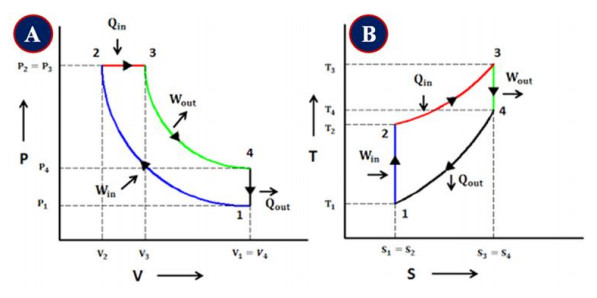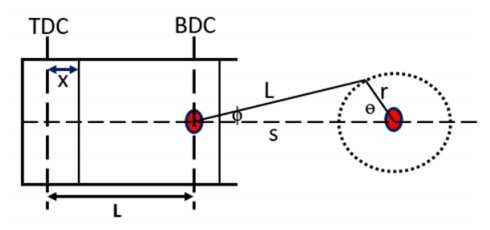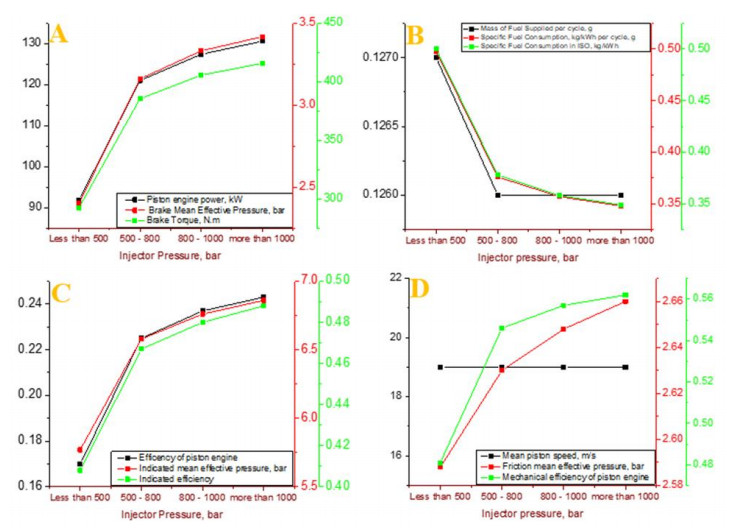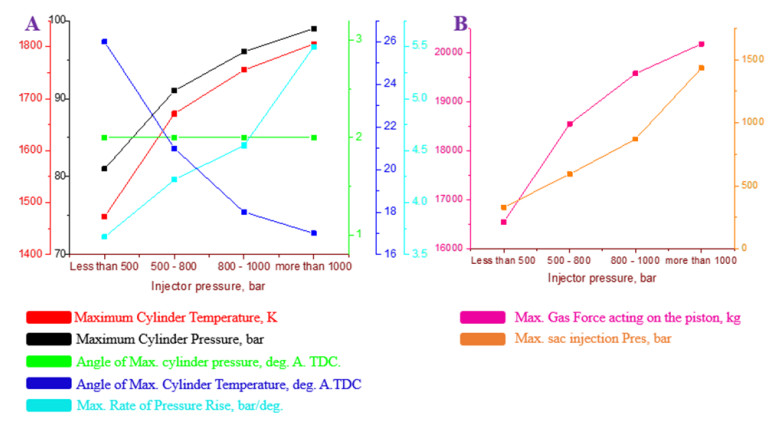In the recent years microfluidic technology has affirmed itself as a powerful tool in medical and biological research. Among the different applications, cell manipulation has been widely investigated. Micro-flowcytometers, micromixers, cell sorters and analyzers are only few examples of the developed devices. Various methods for cell manipulation have been proposed, such as hydrodynamic, magnetic, optical, mechanical, and electrical, in this way categorized according to the manipulating force employed. In particular, when cells are manipulated by hydrodynamic effects, there is no needing of applying external forces. This brings to a simplification in the design and fabrication phase, and at the same time undesired effects on the biological sample are limited. In this paper, we will discuss the physics of the relevant hydrodynamic effects in microfluidics, and how they are exploited for cell manipulation.
1.
Introduction
Combustion engines are major energy converters. As they convert the chemical energy stored in different types of fuel into thermal energy after direct and indirect combustion, then into mechanical energy. Converted energy is used in various engineering applications like transport with its different types and other different applications [1,2,3]. Combustion engines can be classified into different classifications based on a set of bases upon which it depends, the most important of which is the combustion site. Combustion engines can be categorized according to the location of combustion in external and internal combustion engines [4,5,6]. The engine that burns the fuel out and then transfers the energy to it is called the external combustion engine. The engine that burns the fuel inside it and benefits directly from it is called the internal combustion engine [7,8,9,10,11].
Combustion engines are regarded as the foundation of processes to benefit from different energy applications of different types, both traditional and renewable. The engine input comes from different sources, but by using the engine the end product is achieved which is mechanical energy [12,13].
Internal combustion engines are considered the most popular nowadays because of their efficiency and ease of handling. These engines rely on various heat cycles, the best known of which are the Otto and Diesel cycles [14,15,16]. The difference in thermal cycles in the internal combustion engines is fundamental and depends on the type of fuel types used [17,18,19,20,21]. The primary fuel of the Otto cycle is gasoline and the diesel cycle is diesel fuel [22]. The difference in the type of fuel used is the main reason for the difference in the installation and design of the engine. It's because each kind of fuel has its own nature [23,24,25,26,27].
In the development processes of combustion engines, including internal combustion engines. Many researchers around the world have done research on this topic such as, Jafari [28] who concerns about developing an active thermo atmospheric combustion. Negoro et al. [29] study the development of Toyota cars by improving the control of the combustion to be an auto-ignition that ensures more stability inside the engines. Doppalapudi et al. [30] studied the effect of the thermal stresses on parts of the engines such as the piston, connecting rods, and the pin. Where they found that the pressure on the engine pistons of the engine plays an important role in transforming the engine load from the combustion chamber. Which is located inside the cylinder connected to the crankshaft of the engine through the connecting rod.
Depending on the type of fuel used, this has an impact on the design of the engine [1,31,32,33]. The gasoline engine uses the spark plug to finish the combustion of the used fuel and thus complete the engine cycles and benefit from it [34,35,36,37,38]. In the case of the diesel engine, it adopts the self-combustion system. Results from increased the fuel pressure after pumping it through a sprayer until it reaches a point where the direct combustion condition is met. Thus completing the cycle and taking advantage of it [39,40,41,42].
Diesel engines are a major type of engines used nowadays. Due to their great advantages in various engineering areas, they provide high efficiency, and an ideal capability to complete various engineering operations. One of the most important of these applications is the transportation of various types, either by land or marine [43,44,45]. Diesel engines are also used in energy generation, as conventional electric generators use diesel engines due to their durability [46,47]. Diesel engines are considered to be energy efficient. As their fuel consumption depends on the amount of load it performs which is considered less fuel consumption compared with other types of engines [48,49,50,51,52]. Diesel engines are also considered to be one of the safest engines, due to the difficulty of igniting diesel compared to other types of fuel that are used in engines. One of the advantages of using diesel engines is that they produce more torque than other engines at lower rpm levels [53,54].
Since diesel engines were invented until now. The science of engines in general and diesel engines, in particular, has been extensively developed and improved to increase the efficiency of these engines. The developments that the engines have encountered are: the development of the shapes and designs of the combustion chambers, the surfaces of the engine cylinders, and the materials from which the engine is made with its different parts [55,56,57,58,59,60]. Beside the developments that occurred in the engine itself. It was accompanied by a series of improvements and developments in the auxiliary systems of the engine. Which led to the development of the engine's efficiency. These systems include cooling, lubricating, fueling, etc. [61,62,63].
Diesel engines operate within high altitude zone, where the air pressure and density gradually decrease with increasing in altitude. As a result, diesel engines are injected with less air during the intake stroke, causing a decrease in the efficiency of the diesel engine [64]. The turbocharger came as a solution to this issue, as the efficiency of using the turbocharger has been studied by many researchers around the world. Using a turbocharger is not easy because it requires much equipment and most medium and small diesel engines are not equipped with such technology [65,66,67,68]. A proposed solution to these problems is the use of different types of fuels in diesel engines, such as oils of various types and other types of fuel which may operate under these operating conditions. [69,70,71,72,73].
In this work, the effect of changing the pressure of the diesel injected into the engine has been investigated. To investigate the effect of pressure modification on engine performance. It was found that by increasing the diesel fuel injection pressure significantly improved engine performance. Where the used pressure in the first case was less than 500 bar, the second case a pressure between 500 and 800 bar, the third case pressure within 800 to 1000, and the last case a pressure higher than 1000 bar.
2.
Theoretical background
Rudolf diesel in 1892 introduced the diesel cycle as an internal combustion engine compression cycle. Figure 1 shows the P-V and T-S diagrams (A, B) respectively. A diesel cycle consists of two isentropic processes where the entropy is constant, a process with constant pressure, and a constant volume process. The 1–2 as well as 3–4 processes are isentropic processes, the 2–3 process is a constant pressure process, and the 4–1 is a constant volume process [74,75].
The heat input and output inside the diesel cycle can be calculated using Eqs 1 and 2 as following:
The thermal efficiency of the diesel cycle can be calculated by the Eq 3.
The engine piston geometry is shown in Figure 2, which shows the top and bottom dead center pointes. Where the piston is moved within the different strokes of the engine cycle which are: the intake, the compression, the expansion, and the exhaust. In the illustration below the engine geometry can be studied.
The distance between the crank axis and the wrist pin axis (S) is given by:
Where the piston displacement from the TDC is given by:
Instantaneous piston speed is given by:
Mean piston speed is given by:
The power generated within the engine cylinder is referred to as indicated power. Whereas the real available power is called brake power. The difference between the indicated and breaking power is called the friction power. Overall, the mean effective engine pressure using the diesel cycle increases as the initial pressure increases.
3.
Results and discussion
For the purposes of the present study, a four-stroke diesel engine was selected. The engine has 4 cylinders with an inline framework cooled by liquid water. The bore diameter is 160 mm, the piston travel is 190 mm, the engine reveal is 300 rpm, and the compression ratio is 25. The ambient conditions related to this study are 1 bar atmospheric pressure, and 288 K as a normal temperature. The purpose of the study was to study the impact of diesel fuel injection pressure on engine efficiency. Where the selected pressure is below 500,500–800,800–1000, and above 1000 bar for each test. At each injection pressure change, the engine performance parameter is examined and listed below.
The environment parameters of this study are fixed at the variable state of the injector pressure. As the static atmosphere pressure on the sea level is equal to 1 bar with a temperature of 288 K. The static ambient pressure and temperature are 1 bar and 288 K respectively. The exhaust backpressure is equal to 1 bar with the entire pressure of the injector selected. And the overall pressure after the induction air filter with a fixed value of 0.98 bar.
Figure 3 shows the parameters of the efficiency and power of the selected diesel engine in this study. There was a significant increase in piston engine power. As the injector pressure selected ranges from 91.8 kW at the injector pressure of less than 500 bar to 130.5 kW at the injector pressure of more than 1000 bar (See Figure 3A). The brake means effective pressure as well as the brake torque increase with the increase of the injector pressure (See Figure 3A).
The mass of fuel provided per cycle, specific fuel consumption, and specific fuel consumption in ISO are reduced. As the injector pressure increases where the values of the previous parameters are 0.127, 0.126, 0.126, and 0.126 g, 0.498, 0.376, 0.357, and 0.348 kg/kWh, and 0.50, 0.378, 0.358, and 0.349 kg/kWh respectively (See Figure 3B).
The efficiency of the piston engine, the indicated mean effective pressure, and the indicated efficiency increase significantly with the injector pressure increase as the maximum values of the specified parameters are 0.24, 6.8, and 0.48 respectively (See Figure 3C).
The friction means effective pressure as well as the mechanical efficiency of the piston engine are increased with the increasing of the injector pressure. The mean piston speed is remains constant with a value of 19 m/s with the increase in the injector pressure (See Figure 3D).
Table 1 presents the parameters of the selected engine inlet and exhaust system based on the variation in injector pressure. There was a slight increase in the mean inlet manifold temperature and the mean inlet manifold wall temperature with the increase in the injector pressure as the minimum value was 291.5, and 297.5 K at less than 500 bar injector pressure and 292, and 298 K at more than 1000 bar injector pressure respectively. A number of inlet system parameters decrease slightly as the injector pressure increases. For example, the average velocity of gases in the intake manifold, the heat transfer coefficient in the intake manifold, and the heat transfer coefficient in the intake port. The maximum speed in a central section of the inlet port and the total area of the effective valve port gorge remains constant during the injector pressure change. The average exhaust manifold gas temperature as well as the average exhaust manifold wall temperature decreased with the increase of the injector pressure. A small decree occurs at some exhaust parameters as the injector pressure increases. These include the Strouhal number, the maximum speed in the mid-section of the exhaust port, and the heat transfer coefficient in the exhaust manifold. The entire effective valve port throat area remains constant with the increase in injector pressure.
The average inlet manifold pressure and the average exhaust manifold pressure remain constant at 0.96 and 1.04 bar as the injector pressure increases respectively. This provides an indication of the stability of the firing process inside the selected engine with the pressure variation of the injector.
Figure 4 shows the combustion parameters of the selected engine of the study with the variation of the injector pressure. The maximum cylinder temperature and pressure inside the engine increased from 1473.2 K, 81.2 bar at less than 500 bar injector pressure to 1805.2 K, 99 bar at more than 1000 bar respectively. Therefore, the engine combustion is enhanced by increasing the injector pressure (See Figure 4A). The maximum cylinder pressure angle remains constant at a value of 2 degrees as the pressure of the injector increases. During this time, the maximum temperature angle decreased as the injector pressure increased. Values were 26, 21, 18, and 17 degrees respectively with the chosen injector pressure values shown in Figure 4A. The maximum pressure rate rises sharply with the increase of the injector pressure (See Figure 4A). The maximum gas force acting on the engine piston and the maximum suction pressure increased with the increase in the injector pressure (See figure 4B). The result indicates that engine performance is enhanced by increased injector pressure. Because the combustion temperature has increased in value each time.
Figure 5 shows the ecological parameters of the engine chosen for the study with the injection pressure variation. The engine smoke level, the specific particulate emissions, the specific carbon dioxide emissions, and the synthetic NOx emissions decrease considerably with the increase in injector pressure. The maximum reported parameter values are 72.3, 4.25, 1605.6, and 15 at the injector minimum pressure (i.e., less than 500 bar) respectively. Minimum values are 34, 1.4, 1122, and 7 at maximum injector pressure (i.e., higher than 1000 bar).
Table 2 shows the heat exchange parameter of the selected engine of the study with the variation of the injector pressure. The average equivalent temperature of the cycle, the average factor of heat transfers in the cylinder, and the average piston crown temperature are sharply increasing with the increase of the injector pressure as the average equivalent temperature of the cycle started to increase with the following values: 1020.4, 1088.4, 1118, and 1136.6 K respectively. The average factor of the heat transfers in the cylinder started to increase with the following values 449.7,474.6,485.68, and 495.09 W/m2. K respectively. The average piston crown temperature started to increase with the following values 524.47,543.74,552.21, and 558.46 K respectively. The average cylinder liner temperature, and the boiling temperature in the liquid cooling system remain constant with the variation of the injector pressure at a value of 405, and 398 respectively. The rest of the heat exchange parameters are the average head wall temperature, the average temperature of cooled surface head of cylinder head, the average factor of heat transfers from head cooled surface to coolant, the heat flow in a cylinder head, the heat flow in a piston crown, and the heat flow in a cylinder liner are sharply increased with the increase of the injector pressure. The heat exchange parameters show an enhancement in the performance of the selected engine which reflects a result that indicates an increase of the injector pressure will enhance the engine performance with the same amount of the supplied fuel. This will result in more energy being used from the fuel energy supplied to the engine and less engine losses.
4.
Conclusions
This study highlights the effect of the injection pressure increase on the engine to complete the ignition cycle and examines the impact of this increase on engine performance. All performance parameters were observed to be affected by the increase in injector pressure. Consequently, the engine's performance improved.
The compression stroke temperature was increased sharply with the increase of the injector pressure as the temperature for the four trials was 1092, 1097, 1099, and 1101 K for the injector pressure of less than 500,500–800,800–1000, and more than 1000 respectively. Temperature rise is an indicator of the performance improvement of the engine selected in this study.
The increase of the injector pressure aids in enhancement on the emission that comes out of the engine during the operation as the amount of the carbon dioxide, SOx, and NOx are sharply decreased by increasing the injector pressure. It is noted that the increase in the injector pressure enhanced the heat exchange inside the engine as the coefficients of the heat transfer inside the engine affected positively by that increment in the injector pressure.
The exhaust parameter reflects an improvement in engine performance as all exhaust parameters demonstrate a positive impact on engine performance. As a result of that, the average exhaust manifold gas temperature sharply decreased from 909 to 805 K in this study, which is an indicator of the enhancement that occurred to the engine.
Such investigation will aid in improving the performance of the internal combustion engines by highlighting the points where the development can perform and expand to affect the design of the engine to face the new needs.
Conflict of interest
The author declares no conflict of interests for this article.










 DownLoad:
DownLoad:







